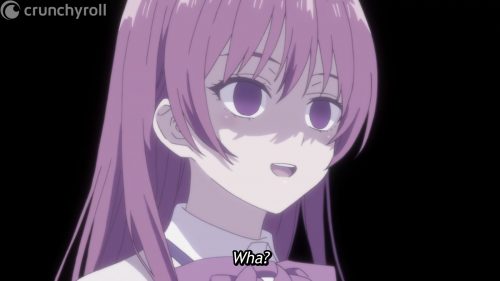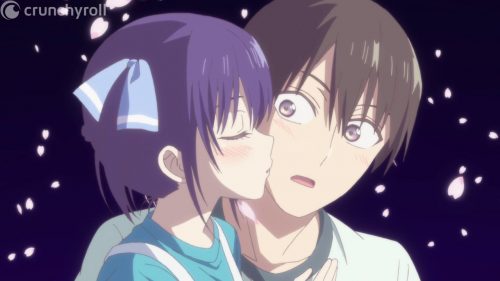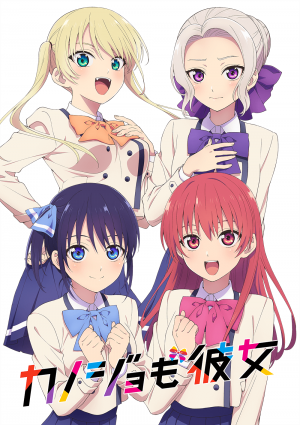
Kanojo mo Kanojo (Girlfriend, Girlfriend) has been quite a rollercoaster of a Summer 2021 title, and for various reasons! The biggest draw to this show was the fact that it features a non-monogamous couple as the central focus, something we don’t really get in anime. We get loads and loads of harems, and to be honest, Girlfriend, Girlfriend is actually one of them! So, now that we’re at the end of the journey, let’s get into the various elements that make this show what it is and finally, whether or not this show is worth the effort of watching it!
Tropes

Like many other romantic comedies in anime, Girlfriend, Girlfriend presents itself with a storyline that is equal parts convenience and reliance on and subversion of the tropes that define the genre. Looking at protagonist Naoya’s relationship with his first girlfriend in the series, Saki, the age-old tropes the anime draws upon include the childhood friend to relationship pipeline, the girl-next-door trope, as well as the rather dated trope of continual rejection to a point – Saki, being Naoya’s childhood friend, spends almost their entire childhood rejecting Naoya’s proclamations of love until she folds one day prior to the events of the series and becomes his girlfriend. Naoya is depicted as a straight-forward, straight-laced, honest guy who absolutely loves Saki and will do anything to make her happy.
Together, Naoya and Saki offer us a kind of “reacher and settler” dynamic that can be the site of a lot of humour, especially in scenes where Naoya overzealously tries to show Saki love because in those moments, he tries to be the perfect boyfriend. This includes the time in the very first episode when he proclaims his love for Saki in class, very loudly, for everyone to hear. Saki is embarrassed of Naoya, but not for who he is, but the ridiculous things he does for her
The main draw to the show is the depiction of a non-monogamous relationship and how it begins; however, in the context of a comedy anime, the main draw is oftentimes the main gag too, which takes away from the novelty of the non-monogamy in the anime. When Naoya receives a confession of love from Minase Nagisa, he subverts the usual expectation of a dense main character who either mishears the confession, or lives in such sheer disbelief of it that literally anything else makes more sense. He does this by accepting her confession and going to Saki to ask for her permission to date them both.
So Much Shame
The main issue with this show is how badly it shames the main characters for the relationship dynamic they choose to pursue. It’s not enough that they’re trying their best to make it work, or that they communicated effectively to actively make the relationship healthy and fulfilling for everyone involved. Girlfriend, Girlfriend makes these characters ashamed of their decision, and therefore, scared of being tried in the court of public opinion, scared of telling their closest friends about it, and even scared of doing something as basic as eating lunch together at school. A lot of how Saki, Naoya and Nagisa’s relationship plays out is based on how they attempt to avoid garnering attention or unknowingly giving away the secret.
Other characters in the show are heavily prejudiced against non-monogamy as a concept, so the relationship never gets talked about in ways that aren’t judgmental or persecute Naoya and Saki in particular.
Naoya himself can’t help but admonish himself for having two girlfriends in the first place. He’s so entrenched in the shame that he can’t help but feel that he could fall in love with anyone if he spent enough time with them, which isn’t necessarily a bad thing either. However, the shame also pushes Naoya to strive towards keeping Saki and Nagisa happy. One of the ways he attempts to do this is through preventing himself from falling in love with a third girl, despite Milika’s continued and intensifying attempts to get to know him better.
The shame fuels the show’s characters and even the show’s main draw - the comedy. The fact that the shame is so pervasive prevents the show from adequately exploring the relationship of these three characters and lacks in the kind of sensitivity you’d come to expect from a romance title. The fact that it’s a comedy pushes Girlfriend, Girlfriend into the territory of using each of its core themes as platforms from which gags emerge, which is what gag anime is supposed to do, but it’s one thing to have comedy around a theme and another to have comedy at the expense of a particular theme, set of characters, et cetera.
Wholesomeness
Despite all the shame in the series, the main characters are actually really involved in each other’s happiness and want what’s best for themselves and the other. The best thing is how (initially) it wasn’t pitting Nagisa and Saki against each other for Naoya’s undivided affection like a harem series would, indicating an attempt at a different kind of romance to what we normally get in anime. That being said, it did eventually boil down to being a harem, and Nagisa and Saki eventually declare that they’re vying for total affection, despite the fact that they’re best friends at this point and have made their non-monogamy work really well for them despite their circumstances. Moments when Naoya declares his affection for them and his desire to make them happy are also among some of Girlfriend, Girlfriend’s best, as it shows a particular sensitivity one doesn’t expect from this show and the way it addresses it’s themes and tropes.
Characters
The characters in Girlfriend, Girlfriend are pretty simple and straightforward, maintaining their general personalities and outlooks on life throughout the series. The one who changes the most is arguably Milika, the third heroine of the series who finds out Naoya, Saki and Nagisa’s secret literally minutes after meeting them. She goes from holding them hostage with knowledge of their secret to falling in love with Naoya for some of the same reasons the other girls do.
Saki is depicted as someone who is capable and mature at school, but she’s different once you get to know her. She experiences many insecurities which are magnified when Naoya asks to date Nagisa, but she’s also critical of her perceived shortcomings (which are often the areas where Nagisa excels). She can be jealous and reactionary, but never tries to do things out of malice, even though the things she does can be rather outlandish. She tells Naoya that Milika’s increased attention is because she is in heat, something that “girls experience from time to time”, because she doesn’t want Naoya catching wind of the fact that Milika has actually developed feelings of her own for him.
Nagisa is someone who is depicted as a cute and thoughtful person who is particularly skilled at tasks around the home like cleaning and cooking. Her adorableness is what breaks down Saki’s guard in the beginning, as well as her honest and earnest feelings for Naoya. She’s wholesome from beginning to end, and she’s also not above making her relationship with Naoya secondary to his relationship with Saki. She sacrifices quality time the three of them could have spent together on their field trip when Saki’s best friend, Kiryuu Shino, becomes suspicious of Naoya’s “two-timing” and begins to investigate.
Nagisa acts as a decoy or pretends to be bumping into Naoya and Saki by chance while touring with Milika, who is trying to take bold steps towards furthering and nurturing her relationship with Naoya. This is part of Milika’s growth as a character, and her bravery in trying to win Naoya’s heart despite having had an unfavourable opinion of him at first is quite similar to that of Nakano Nino of The Quintessential Quintuplets, who, interestingly enough, is voiced by the same actor, Taketatsu Ayana.
Naoya is honest to a fault, straightforward to the point of lunacy, and extremely invested in trying to make things work with his girlfriends. This brazen honesty has gotten the main group into some wild situations, like when Milika overhears them talking about their relationship when she first meets them in the gym storage. It also makes his girlfriend gush sometimes, but most of the time, his open displays of affection towards Saki can be overwhelming. The dynamic Naoya ends up creating through inviting his girlfriends to live with him in the same house is interesting, because it’s not only that Saki and Nagisa are his girlfriends with their own individual relationships with him, but they develop a relationship with each other because their lives are so deeply intertwined.
Ending
The ending of Girlfriend, Girlfriend was a bit of a cliffhanger in certain aspects. While it feels conclusive enough, we still have questions answered about the true intentions of Kiryuu Shino, Saki’s best friend. It’s implied that she has a crush on Naoya too, but what does that mean? She reflects on her intentions, saying something about wanting to solidify Saki’s relationship with Naoya so that she can get over someone – is that someone Naoya? Or is it Saki? Will we ever know?

Final Thoughts
Kanojo mo Kanojo (Girlfriend, Girlfriend) is a fun series, no doubt, but there are a lot of things about it that could have been done a lot better, with a lot more sensitivity and thought. That’s not to say that we didn’t enjoy it, but that it could have been a much more significant moment for romance anime as a genre, perhaps even the start of more anime exploring non-monogamous relationships in a way that isn’t the age-old harem trope we’ve come to expect when the tags “comedy” and “romance” come together. What did you think about this Summer 2021 anime? Drop a comment below and share your thoughts!

Recommended Post




